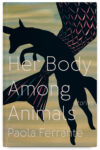
Illustrations by H.C. Dunaway Smith
[Burrow Press; 2021]
Note: Rancher is a book discussing sexual assault. As such, this review includes discussions about sexual violence that some readers may wish to avoid.
The first line in Selah Saterstrom’s new book, Rancher, reads “My rapist bought a house with a swimming pool in El Paso.” The next line says, “One issue I’m having while writing this essay is that I have nothing interesting to say about rape. Not even my own(s).”
The combination of those two lines—the observation and the disavowal—sets up the first paradox in a short book full of paradoxes. Saterstrom does, in fact, have something interesting to say about rape—precisely that it feels like she has nothing interesting to say. When she writes, “I do not want the ideally achieved sentence about rape. I do not want rape as a narrative device,” she clarifies one of the paradoxes. Rape is a profoundly impactful, psyche-altering trauma, and a commonplace behavior in our culture; as Saterstrom observes, “Additionally, my rapist is not interesting.”
The first thing we learn in the book is that the rapist lives in a one-story, ranch style home in El Paso. Internet sleuthing fails to turn up his job or any other info. He is very nondescript, a contrast to the singularly hideous role he played in the author’s life. For years, Saterstrom had believed the man was dead because a mutual acquaintance claimed to have even witnessed the rapist’s death, but, in a snubbing cosmic justice, he is actually alive, living a mundane-if-comfortable life.
What does it mean that he’s alive and not in jail or suffering some of overt punishment? How can he live a comfortable life he does not deserve?
Ultimately, these are unresolvable questions. The essay makes clear that what happens to the innocent person matters more than what becomes of the guilty one. As one of Saterstrom’s friends observes near the conclusion, “The person . . . most touched by the essay on rape is the essayist. It is her healing, first and foremost, that is at stake.” No matter how profoundly the rapist’s actions affected the victim, the man himself, separated from that act, is nothing. Or not much, anyway. A boring man in a boring ranch house.
To describe rape in detail risks shocking the reader by trying to capture violence in language. To discuss rape as a socio-cultural phenomenon leaches the trauma from the act; facts and research cannot capture victimization, suffering, and resilience. Anything within the lurid-to-clinical spectrum amplifies the shortcomings of both narrative approaches without tempering or enhancing either. Neither the ideal sentence nor the narrative device conveys anything a reader might be justified in calling truth, even if they find the writing interesting.
Saterstrom makes us ask, does an essay about rape need to be “interesting?” How could a writer anticipate what a reader will find interesting about rape rather than offensive, triggering, harmful, shocking, or liberating? Can an ethical reader describe an essay about rape as “interesting” without lacking empathy for a victim or failing to internalize the gravity of the subject?
Does anyone have anything interesting to say about rape?
Certainly, Saterstrom has many interesting things to say in Rancher. She begins by writing about black widow spiders and their mating cycle, in which the female sometimes consumes the male after copulation. To me, the long-time keeper of a pet black widow, it is extremely interesting to read about the author’s friend who freezes a spider’s egg sacs to preserve the spider while preventing infestation. In nature, reproduction and violence overlap.
Soon after spending time with spiders, we learn that, during an Ebola outbreak in Liberia, “10% of children who lost at least one parent to Ebola were forced into sex work.” Saterstrom draws connections between pandemics and other forms of disaster, such as economic crises, which also spur outbreaks of violence against women. In this context, Saterstrom asks, “What does capitalism have to do with our rapes? Everything. A national lack of infrastructure, revealed by every disaster, ensures it.”
As if this direct indictment doesn’t go far enough, she adds, “Capitalism is in the soggy corner of the room; it is in the acrid dog piss saturated carpet. It is in the polyester slick of the popped, fitted sheet. It is in the clean angle of morning as another day begins.”
Rape, an exploitation, fits into a larger system that supports and facilitates exploitation. A system that creates ways to be vulnerable so that others can be elevated creates conditions for exploitation. A corner of a room, a filthy carpet, and a ruined sheet invoke imagery of corrupted structures and foundations; the “clean angle” of a new morning welcomes another day of the same ruined and disgusting conditions. Until society is not structurally and ideologically reliant upon exploitation, victimization remains a constant, if disgusting, aspect of life.
The essay veers into many more tangential but carefully connected directions. We encounter Saint Maria Teresa Goretti, whose late childhood rape spurred a story involving her apparition forgiving her assailant. The tale resulted in both of them being canonized. A century later, girls at a Philadelphia Catholic school named in St. Maria’s honor mob attacked a man who continually exposed his genitals to them. They kicked in his teeth.
The black widow’s cannibalism and the Catholic school girls’ retribution remind readers that sexual violence can be dangerous for the perpetrator, not just for the victim. Soon after receiving a private investigator’s information on her rapist, Saterstrom wonders what it would be like to kill him. She writes:
I’d be a tool-free killer. I don’t want to open the body. When I imagine killing him, I see myself laying hands on him. Like the faith healers of my childhood who would lay hands on a janky human as they channeled the Holy Spirit into them. Except in this case, obviously, I would not be healing him. Or, I would be “healing” him.
As previously mentioned, Rancher is often tangentially arranged, but never feels so. The various elements balance and weave until the reader’s thoughts conform to the patterns of the essay. Also, even when the narrative heads into very new territories, each meditation clearly deepens the reader’s understanding of how one might grapple with trauma. To discuss the infuriating and isolating reality of others not believing a victim’s trauma, Saterstrom references her own 278-page book of feminist hermeneutics that delved into the episode when a post-resurrected Christ forbids Mary Magdalene from touching him. The “logic” that follows from Christ’s denial of Mary Magdalene is that if a woman cannot touch Christ, she cannot touch his body (the Bible), and therefore she cannot learn or teach herself. What a woman says is not to be believed because she cannot access or convey truth.
Saterstrom’s externalizing of her introspection encourages readers to look within themselves, too. There’s a lot to learn there. The ways she explains Christian exegesis align with what I was taught at a conservative evangelical church in my own youth: Women are flawed, Eve caused the Fall, man is the head of the household, women should not lead a congregation, and so on. At the time, I wondered how women could tolerate the condescension. Now I better understand the power of group conditioning, but if acceptance of misogyny confused me then, Saterstrom’s fury at being denied credibility fulfill my expectations now: “Imagine screaming in someone’s face, but that someone does not hear you. Imagine the isolation you might feel. You might begin to wonder if you are a ghost. And this is why no one can hear you screaming.” Disregard is not denial.
Saterstrom offers glimpses of her adolescence in the community that harbored her rapist and allowed him to rape her. The sections of the book about this southern community that Saterstrom grew up in often focus on humiliation and cruelty. Her mother sexualizes her in front of adults, drawing attention to her vagina with a joke about an alligator bite. She endured weight shaming with names like “Orca” or jokes about bear claws from Piggly Wiggly. We learn about her childhood dependency on food and how shaming affected her. As a person who grew up in a rural community, I recognized the types of dumbness and awfulness endemic to such insular communities and the victims of sexual violence in my own hometown. Rancher clarified the connections between humiliation and sexual violence that I’d only sensed before.
Interspersed throughout the text, H.C. Dunaway Smith’s colorful, complex, surreal artwork blends human and natural images, hybrid flowers with human mouths where the pistil or stamen would go. Thistle stalks sprout from a vaginal canal and uterus winged with overlapping human legs. The artwork disassembles bodies and reassembles them as intricate, living hybrids. Like Selah Saterstrom’s words, the images make you question what you see, and what you think you know. Nowhere does the artwork remind the viewer of a boring ranch house with a pool.
The book ends with a litany of sorts, a few pages of quotations from the author’s friends. Each brilliant in their own way, each offering a perspective on rape or other trauma. The weight of the collective effort feels profound. In one of the final sections, a friend named Teresa observes, “The brain will only let us see that which we are ready to face; the concentrated focus of an essay—the deep stillness and inner knowing felt during the writing process—creates the conditions for seeing, witnessing, our own pain.”
From the view at the conclusion of Rancher, what does that pain look like? It looks like strength. With each seemingly tangential anecdote or personal history, Saterstrom creates a web in which each strand represents another mechanism of victimization. In this book, that means rape. There are many strands—millennia-old religious ideology, patterns of systemic shame, violence. A victim suffers trauma from forces greater than one person—far more potent than the boring rapist. Under the concerted systems of violence, it takes great strength to stand up and talk about what happened.
Eric Aldrich is a writer from Tucson, Arizona. His recent work appears in Terrain.org, Deep Wild, and Full Stop. Learn more about Eric’s current projects on his website, ericaldrich.net.
This post may contain affiliate links.







